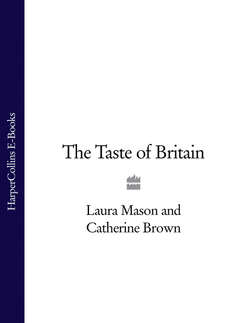Читать книгу The Taste of Britain - Hugh Fearnley-Whittingstall - Страница 8
Baydon Hill Cheese
ОглавлениеDESCRIPTION:
AN UNPASTEURIZED COW’S AND SHEEP’S MILK CHEESE. WEIGHT: 2 SIZES, THE LARGER WEIGHS ABOUT 2.3KG; THE SMALLER ABOUT 450G. FORM: THE LARGER IS A TRUCKLE (TALL CYLINDER); THE SMALLER IS A ROUND OR LOAF, AS SUCH CHEESES ARE KNOWN LOCALLY. COLOUR: THAT OF THE COW’S MILK CHEESE IS GOLDEN YELLOW; THE SHEEP’S MILK VERSION IS A PALER, BUTTERY COLOUR; BOTH ARE WAXED WITH NATURAL BEESWAX. FLAVOUR AND TEXTURE: THE COW’S MILK CHEESE IS MILD AND CREAMY; THE SHEEP’S MILK CHEESE IS DENSER, WITH A SWEET RICH FLAVOUR.
HISTORY:
This is a modern version of a cheese formerly known as Wiltshire. Its history over the past 200 years is fairly well documented. It is related by method to Cheddar and Gloucester cheeses; as with the latter, both a thick and a thin version were known in the past. Val Cheke (1959) estimates that in 1798 5,000 tons of North Wiltshire cheese were made. This was said to be of excellent quality and in part was attributed to the particular method of dairying in Wiltshire which allowed for consistency in temperature and method. At this time, the milk of Longhorn cattle was used; these have long since been replaced by modern dairy breeds. As with Cheddar, there is some evidence for communal cheese-making. Small cheeses, known as Wiltshire loaves, and larger ones, similar to Gloucesters, are both recorded. A sheep’s milk cheese is now made to the same recipe.
The local cheese-making industry declined rapidly after 1914-18 and remained a memory until Jo Hale, a farmer’s wife, began her research in the late 1980s. She located a family recipe for North Wiltshire Cheese and has developed it for both sheep’s and cow’s milk under the name of Baydon Hill, where she lives.
TECHNIQUE:
The milk comes from a flock of British Friesland sheep, pastured in the valley of the River Avon, or from the maker’s herd of cattle, mostly Friesians with a little Guernsey, feeding on semi-permanent ley pasture. It is not pasteurized. The method is the same for both cheeses.
Starter is added, plus annatto, followed shortly afterwards by a vegetarian rennet, and the milk left for the curd to form. It is cut into cubes of roughly 1cm. The temperature is raised slightly and the curd stirred for about 100 minutes until the correct acidity is reached; then it is allowed to settle for a few minutes and the whey is drained off. The curd is cut in blocks and turned up to 5 times; the number of turns varies according to the state of the milk, and fewer turns may be required with the sheep’s milk curd. The curd is milled, salted and put into moulds. It is pressed for about 2 days, the cheeses being turned once. The cheeses are removed from their moulds; the larger ones are larded and bandaged, the smaller ones simply larded. They are stored for 4 months, turned daily for the first 6 weeks and once a week thereafter; then they are washed, dried, waxed and distributed.
REGION OF PRODUCTION:
SOUTH WEST, WILTSHIRE.
